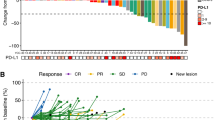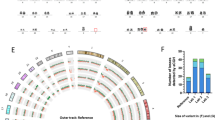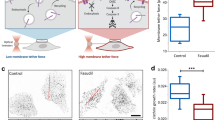Abstract
Resveratrol (3,5,4′-trihydroxy-trans-stilbene), in the concentration range of 20 μM and above, induced arrest in the S-phase and apoptosis in the T cell-derived T-ALL lymphocytic leukemia cell line CEM-C7H2 which is deficient in functional p53 and p16. Expression of transgenic p16/INK4A, which causes arrest in G0/G1, markedly reduced the percentage of apoptotic cells. Antagonist antibodies to Fas or FasL, or constitutive expression of crmA did not diminish the extent of resveratrol-induced apoptosis. Furthermore, a caspase-8-negative, Fas-resistant Jurkat cell line was sensitive to resveratrol-induced apoptosis which could be strongly inhibited in the Jurkat as well as in the CEM cell line by z-VAD-fmk and z-IETD-fmk. The almost complete inhibition by z-IETD-fmk and the lack of inhibition by crmA suggested caspase-6 to be the essential initiator caspase. Western blots revealed the massive conversion of procaspase-6 to its active form, while caspase-3 and caspase-2 were proteolytically activated to a much lesser extent. Cell Death and Differentiation (2000) 7, 834–842
Similar content being viewed by others
Log in or create a free account to read this content
Gain free access to this article, as well as selected content from this journal and more on nature.com
or
Abbreviations
- Fas:
-
APO-1/CD95
- FasL:
-
Fas ligand
- rsFasL:
-
recombinant soluble FasL
- FACS:
-
fluorescence activated cell sorter
- FITC:
-
fluorescein isothiocyanate
- PBS:
-
phosphate buffered saline
- TBS:
-
TRIS buffered saline
- SDS:
-
sodium dodecyl sulfate
- crmA:
-
cytokine response modifier A
- TNFα:
-
tumor necrosis factor α
References
Jang M, Cai L, Udeani GO, Slowing KV, Thomas CF, Beecher CWW, Fong HHS, Farnsworth NR, Kinghorn AD, Mehta RG, Moon RC and Pezzuto JM . (1997) Cancer chemopreventive activity of resveratrol, a natural product derived from grapes. Science 275: 218–220
Pace-Asciak CR, Hahn S, Diamandis EP, Soleas G and Goldberg DM . (1995) The red wine phenolics trans-resveratrol and quercetin block human platelet aggregation and eicosanoid synthesis: Implications for protection against coronary heart disease. Clin. Chim. Acta 235: 207–219
Kimura Y, Okuda H and Arichi S . (1985) Effects of stilbenes on arachidonate metabolism in leukocytes. Biochim. Biophys. Acta 834: 275–278
Arichi H, Kimura Y, Okuda H, Baba K, Kozawa M and Arichi S . (1982) Effects of stilbene components of the roots of Polygonum cuspidatum Sieb. et Zucc. on lipid metabolism. Chem. Pharm. Bull. (Tokyo) 30: 1766–1770
Frankel EN, Waterhouse AL and Kinsella JE . (1993) Inhibition of human LDL oxidation by resveratrol. Lancet 341: 1103–1104
Frankel EN, Kanner J, German JB, Parks E and Kinsella JE . (1993) Inhibition of oxidation of human low-density lipoprotein by phenolic substances in red wine. Lancet 341: 454–457
Kerry NL and Abbey M . (1997) Red wine and fractionated phenolic compounds prepared from red wine inhibit low density lipoprotein oxidation in vitro. Atherosclerosis 135: 93–102
Renaud S and de Lorgeril M . (1992) Wine, alcohol, platelets, and the French paradox for coronary heart disease. Lancet 339: 1523–1526
Soleas GJ, Diamandis EP and Goldberg DM . (1997) Resveratrol: a molecule whose time has come? And gone? Clin. Biochem. 30: 91–113
Nonomura S, Kanagawa H and Makimoto A . (1963) Chemical constituents of polygonaceous plants. I. Studies on the components of KO-jo-kon. (Polygonum cuspidatum Sieb. et Zucc.). Yakugaku Zasshi 83: 988–990
Kubo M, Kimura Y, Shin H, Haneda T, Tani T and Namba K . (1981) Studies on the antifungal substance of crude drug (II). On the roots of Polygonum cuspidatum Sieb. et Zucc. (Polygonaceae). Shoyakugaku Zasshi 35: 58–61
Clement MV, Hirpara JL, Chawdhury SH and Pervaiz S . (1998) Chemopreventive agent resveratrol, a natural product derived from grapes triggers CD95 signaling-dependent apoptosis in human tumor cells. Blood 92: 996–1002
Carbó N, Costelli P, Baccino FM, López-Soriano FJ and Argilés JM . (1999) Resveratrol, a natural product present in wine, decreases tumour growth in a rat tumour model. Biochem. Biophys. Res. Commun. 254: 739–743
Hsieh TC and Wu JM . (1999) Differential effects on growth, cell cycle arrest, and induction of apoptosis by resveratrol in human prostate cancer cell lines. Exp. Cell Res. 249: 109–115
Hsieh TC, Juan G, Darzynkiewicz Z and Wu JM . (1999) Resveratrol increases nitric oxide synthase, induces accumulation of p53 and p21WAF1/CIP1, and suppresses cultured bovine pulmonary artery endothelial cell proliferation by perturbing progression through S and G2 . Cancer Res. 59: 2596–2601
Fontecave M, Lepoivre M, Elleingand E, Gerez C and Guittet O . (1998) Resveratrol, a remarkable inhibitor of ribonucleotide reductase. FEBS Lett. 421: 277–279
Sun NJ, Woo SH, Cassady JM and Snapka RM . (1998) DNA polymerase and topoisomerase II inhibitors from Psoralea corylifolia. J. Nat. Prod. 61: 362–366
Fang N and Casida JE . (1998) Anticancer action of cubé insecticide: correlation for rotenoid constituents between inhibition of NADH:ubiquinone oxidoreductase and induced ornithine decarboxylase activities. Proc. Natl. Acad. Sci. USA 95: 3380–3384
Mgbonyebi OP, Russo J and Russo IH . (1998) Anitproliferative effect of synthetic resveratrol on human breast epithelial cells. Int. J. Oncol. 12: 865–869
ElAttar TM and Virji AS . (1999) Modulating effect of resveratrol and quercetin on oral cancer cell growth and proliferation. Anticancer Drugs 10: 187–193
Nicoletti I, Migliorati G, Pagliacci MC, Grignani F and Riccardi C . (1991) A rapid and simple method for measuring thymocyte apoptosis by propidium iodide staining and flow cytometry. J. Immunol. Methods 139: 271–279
Martin SJ, Reutelingsperger CPM and Green DR . (1996) Annexin V: a specific probe for apoptotic cells. In Techniques in apoptosis Cotter TG and Martin SJ, eds (London: Portland Press Ltd) pp. 107–120
Sharpless NE and DePinho RA . (1999) The INK4A/ARF locus and its two gene products. Curr. Opin. Genetics Dev. 9: 22–30
Bernhard D, Ausserlechner MJ, Tonko M, Löffler M, Hartmann BL, Csordas A and Kofler R . (1999) Apoptosis induced by the histone deacetylase inhibitor sodium butyrate in human leukemic lymphoblasts. FASEB J. 13: 1991–2001
Geley S, Hartmann BL, Kapelari K, Egle A, Villunger A, Heidacher D, Greil R, Auer B and Kofler R . (1997) The interleukin 1β-converting enzyme inhibitor CrmA prevents Apo/Fas- but not glucocortoid-induced poly(ADP-ribose) polymerase cleavage and apoptosis in lymphoblastic leukemia cells. FEBS Lett. 402: 36–40
Garcia-Calvo M, Peterson EP, Leiting B, Ruel R, Nicholson DW and Thornberry NA . (1998) Inhibition of human caspases by peptide-based and macromolecular inhibitors. J. Biol. Chem. 273: 32608–32613
Ekert PG, Silke J and Vaux DL . (1999) Caspase inhibitors. Cell Death Differ. 6: 1081–1086.
Nicholson DW . (1999) Caspase structure, proteolytic substrates, and function during apoptotic cell death. Cell Death Differ. 6: 1028–1042
Juo P, Kuo CJ, Yuan J and Blenis J . (1998) Essential requirement for caspase-8/FLICE in the initiation of the Fas-induced apoptotic cascade. Curr. Biol. 8: 1001–1008
Hirata H, Takahashi A, Kobayashi S, Yonehara S, Sawai H, Okazaki T, Yamamoto K and Sasada M . (1998) Caspases are activated in a branched protease cascade and control distinct downstream processes in Fas-induced apoptosis. J. Exp. Med. 187: 587–600
Enari M, Sakahira H, Yokoyama H, Okawa K, Iwamatsu A and Nagata S . (1998) A caspase-activated DNase that degrades DNA during apoptosis, and its inhibitor ICAD. Nature 391: 43–50
Tewari M and Dixit VM . (1995) Fas- and tumor necrosis factor-induced apoptosis is inhibited by the poxvirus crmA gene product. J. Biol. Chem. 270: 3255–3260
Miura M, Friedlander RM and Yuan J . (1995) Tumor necrosis factor-induced apoptosis is mediated by a CrmA-sensitive cell death pathway. Proc. Natl. Acad. Sci. USA 92: 8318–8322
Della Ragione F, Cucciolla V, Borriello A, Della Pietra V, Racioppi L, Soldati G, Manna C, Galletti P and Zappia V . (1998) Resveratrol arrests the cell division cycle at S/G2 phase transition. Biochem. Biophys. Res. Commun. 250: 53–58
Fukuhara K and Miyata N . (1998) Resveratrol as a new type of DNA-cleaving agent. Bioorg. Med. Chem. Lett. 8: 3187–3192
Strasser-Wozak EM, Hartmann BL, Geley S, Sgonc R, Böck G, Santos AJ, Hattmannstorfer R, Wolf H, Pavelka M and Kofler R . (1998) Irradiation induces G2/M cell cycle arrest and apoptosis in p53-deficient lymphoblastic leukemia cells without affecting Bcl-2 and Bax expression. Cell Death Differ. 5: 687–693
Villunger A, Egle A, Kos M, Hartmann BL, Geley S, Kofler R and Greil R . (1997) Drug-induced apoptosis is associated with enhanced Fas (Apo-1/CD95) ligand expression but occurs independently of Fas (Apo-1/CD95) signaling in human T-acute lymphatic leukemia cells. Cancer Res. 57: 3331–3334
Takahashi A, Alnemri ES, Lazebnik YA, Fernandes-Alnemri T, Litwack G, Moir RD, Goldman RD, Poirier GG, Kaufmann SH, Earnshaw WC . (1996) Cleavage of lamin A by Mch2α but not CPP32: Multiple interleukin 1β-converting enzyme-related proteases with distinct substrate recognition properties are active in apoptosis. Proc. Natl. Acad. Sci. USA 93: 8395–8400
Orth K, Chinnaiyan AM, Garg M, Froelich CJ and Dixit VM . (1996) The CED-3/ICE-like protease Mch2 is activated during apoptosis and cleaves the death substrate lamin A. J. Biol. Chem. 271: 16443–16446
Van de Craen M, Declercq W, Van den brande I, Fiers W and Vandenabeele P . (1999) The proteolytic procaspase activation network: an in vitro analysis. Cell Death Differ. 6: 1117–1124
Subbaramaiah K, Chung WJ, Michaluart P, Telang N, Tanabe T, Inoue H, Jang M, Pezzuto JM and Dannenberg AJ . (1998) Resveratrol inhibits cyclooxygenase-2 transcription and activity in phorbol ester-treated human mammary epithelial cells. J. Biol. Chem. 273: 21875–21882
Gehm BD, McAndrews JM, Chien PY and Jameson JL . (1997) Resveratrol, a polyphenolic compound found in grapes and wine, is an agonist for the estrogen receptor. Proc. Natl. Acad. Sci. USA 94: 14138–14143
Stahl S, Chun TY and Gray WG . (1998) Phytoestrogens act as estrogen agonists in an estrogen-responsive pituitary cell line. Toxicol. Appl. Pharmacol. 152: 41–48
Turner RT, Evans GL, Zhang M, Maran A and Sibonga JD . (1999) Is resveratrol an estrogen agonist in growing rats? Endocrinology 140: 50–54
Lu R and Serrero G . (1999) Resveratrol, a natural product derived from grape, exhibits antiestrogenic activity and inhibits the growth of human breast cancer cells. J. Cell Physiol. 179: 297–304
Ashby J, Tinwell H, Pennie W, Brooks AN, Lefevre PA, Beresford N and Sumpter JP . (1999) Partial and weak oestrogenicity of the red wine constituent resveratrol: consideration of its superagonist activity in MCF-7 cells and its suggested cardiovascular protective effects. J. Appl. Toxicol. 19: 39–45
Maccarrone M, Lorenzon T, Guerrieri P and Finazzi Agrò A . (1999) Resveratrol prevents apoptosis in K562 cells by inhibiting lipoxygenase and cyclooxygenase activity. Eur. J. Biochem. 265: 27–34
Tsujii M and DuBois RN . (1995) Alterations in cellular adhesion and apoptosis in epithelial cells overexpressing prostaglandin endoperoxide synthase 2. Cell 83: 493–501
Hollstein M, Sidransky D, Vogelstein B and Harris CC . (1991) p53 mutations in human cancers. Science 253: 49–53
Levine AJ, Momand J and Finlay CA . (1991) The p53 tumour suppressor gene. Nature 351: 453–456
Otsuki T, Clark HM, Wellmann A, Jaffe ES and Raffeld M . (1995) Involvement of CDKN2(p16INK4A/MTS1) and p15INK4B/MTS2 in human leukemias and lymphomas. Cancer Res. 55: 1436–1440
Huang C, Ma WY, Goranson A and Dong Z . (1999) Resveratrol suppresses cell transformation and induces apoptosis through a p53-dependent pathway. Carcinogenesis 20: 237–242
Midgley CA, Owens B, Briscoe CV, Thomas DB, Lane DP and Hall PA . (1995) Coupling between gamma irradiation, p53 induction and the apoptotic response depends upon cell type in vivo. J. Cell Sci. 108: 1843–1848
MacFarlane M, Jones NA, Dive C and Cohen GM . (1996) DNA-damaging agents induce both p53-dependent and p53-independent apoptosis in immature thymocytes. Mol. Pharmacol. 50: 900–911
Strasser-Wozak EMC, Hattmannstorfer R, Hala M, Hartmann BL, Fiegl M, Geley S and Kofler R . (1995) Splice site mutation in the glucocorticoid receptor gene causes resistance to glucocorticoid-induced apoptosis in a human acute leukemic cell line. Cancer Res. 55: 348–353
Norman MR and Thompson EB . (1977) Characterization of a glucocorticoid-sensitive human lymphoid cell line. Cancer Res. 37: 3785–3791
Gossen M and Bujard H . (1992) Tight control of gene expression in mammalian cells by tetracycline-responsive promoters. Proc. Natl. Acad. Sci. USA 89: 5547–5551
Gossen M, Freundlieb S, Bender G, Müller G, Hillen W and Bujard H . (1995) Transcriptional activation by tetracyclines in mammalian cells. Science 268: 1766–1769
Bernhard D, Löffler M, Hartmann BL, Yoshida M, Kofler R and Csordas A . (1999) Interaction between dexamethasone and butyrate in apoptosis induction: non-additive in thymocytes and synergistic in a T cell-derived leukemia cell line. Cell Death Differ. 6: 609–617
Sgonc R and Wick G . (1994) Methods for the detection of apoptosis. Int. Arch. Allergy Immunol. 105: 327–332
Acknowledgements
This work was supported by grants from the Austrian Science Fund (SFB-F204), the Österreichische Krebshilfe-Krebsgesellschaft Tirol and the Province of Tyrol. We are indebted to Ms. Rajam Csordas-Iyer for critical reading and editorial assistance.
Author information
Authors and Affiliations
Corresponding author
Additional information
Edited by A Finazzi-Agrò
Rights and permissions
About this article
Cite this article
Bernhard, D., Tinhofer, I., Tonko, M. et al. Resveratrol causes arrest in the S-phase prior to Fas-independent apoptosis in CEM-C7H2 acute leukemia cells. Cell Death Differ 7, 834–842 (2000). https://doi.org/10.1038/sj.cdd.4400719
Received:
Revised:
Accepted:
Published:
Issue date:
DOI: https://doi.org/10.1038/sj.cdd.4400719
Keywords
This article is cited by
-
Effect of methoxy stilbenes—analogs of resveratrol—on the viability and induction of cell cycle arrest and apoptosis in human myeloid leukemia cells
Molecular and Cellular Biochemistry (2020)
-
Resveratrol sequentially induces replication and oxidative stresses to drive p53-CXCR2 mediated cellular senescence in cancer cells
Scientific Reports (2017)
-
Establishment of a picloram-induced somatic embryogenesis system in Vitis vinifera cv. chardonnay and genetic transformation of a stilbene synthase gene from wild-growing Vitis species
Plant Cell, Tissue and Organ Culture (PCTOC) (2015)
-
Modulation of doxorubicin cytotoxicity by resveratrol in a human breast cancer cell line
Cancer Cell International (2012)
-
Co-expression of VpROMT gene from Chinese wild Vitis pseudoreticulata with VpSTS in tobacco plants and its effects on the accumulation of pterostilbene
Protoplasma (2012)



